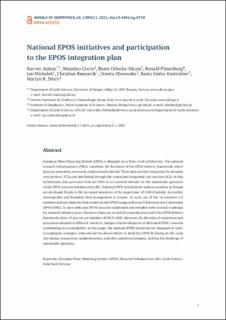| dc.description.abstract | European Plate Observing System (EPOS) is designed on a three-level architecture. The national research infrastructures (NRIs) constitute the backbone of the EPOS delivery framework, where data are generated, processed, analyzed and archived. These data are then integrated by thematic core services (TCS) and distributed through the centralized integrated core services (ICS). In this architecture, data provision from the NRIs is an essential element for the sustainable operation of the EPOS research infrastructure (RI). National EPOS initiatives in various countries in Europe are developed thanks to the increased awareness of the importance of FAIR (Findable, Accessible, Interoperable and Reusable) data management in science. As such, out of the 14 countries (13 members and one observer) that constitute the EPOS European Research Infrastructure Consortium (EPOS-ERIC), 11 have dedicated EPOS consortia established and included in the national roadmaps for research infrastructures. Moreover, there are in total 24 countries involved in the EPOS delivery framework where 10 are not yet members of EPOS-ERIC. However, the diversity of regulations and procedures adopted in different countries, hampers the development of dedicated EPOS consortia contributing to sustainability. In this paper, the national EPOS initiatives are discussed in order to emphasize synergies achieved and the shared efforts to build the EPOS RI during its life-cycle (the design, preparation, implementation, and pilot operational phases), tackling the challenge of sustainable operation. | en_US |

